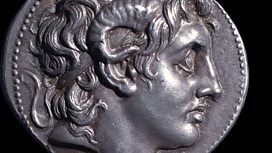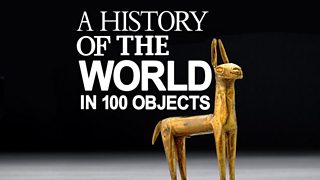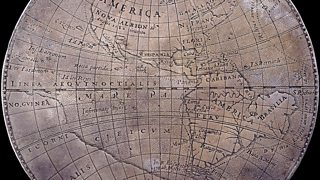Taino ritual seat
The history of humanity as told through surviving objects. Today Neil MacGregor tells the story of a beautifully carved ritual seat from a lost Caribbean culture.
The history of humanity as told through one hundred objects from the British Museum. This week the Museum's director, Neil MacGregor, is exploring high status objects from across the world around 700 years ago.
Today he tells the story of a beautifully carved ritual seat - an object which has survived the destruction of the Caribbean culture that produced. This four legged wooden stool, or duho, with its long shape and wide-eyed face probably belonged to a chief, or "cacique" of the Taino people of the Caribbean. Taino was a term used to describe a spectrum of peoples who originated in South America and who populated the whole region, including Cuba, Hispaniola, Puerto Rico and Jamaica. Neil tells the story of the Taino speaking people and their demise following the arrival of Europeans. The archaeologist Jose Oliver looks at how the Taino spread around the Caribbean while the Puerto Rican scholar Gabriel Haslip-Vieira explains their impact on the region today.
Producer: Anthony Denselow
Last on
More episodes
Next
You are at the last episode
![]()
More programmes from A History of the World in 100 Objects related to leaders & government
About this object
Location: Santa Domingo, Caribbean
Culture: Aztec, Maya and Central America
Period: 1200 - 1400
Material: Gold and Wood
��
This wooden seat known as a duho was sculpted by a Taino artisan. The Taino were one of the pre-European, native peoples of the Caribbean. It is carved in the shape of an ancestor spirit known as a cemi. Duhos were used to communicate with the spirit world. A Taino chief would sit in his duho and then snort psychedelic snuff made from the seeds of the cohoba tree. They would then ask the spirits for advice on the future, such as whether to go to war.
What was Taino society like?
Before the arrival of Europeans, the Caribbean was home to two main ethnic groups - the Taino and the Caribs. The Taino generally lived in the northern islands including Cuba, Jamaica and the Bahamas, while the Caribs lived in the southern islands. The Taino were farmers who lived in highly-organised societies, divided into nobles and commoners. They were ruled by both male and female chiefs. Only the chief or an important visitor could sit in a duho. Christopher Columbus was given this honour when he arrived in the Caribbean in 1492.
Did you know?
- Some Taino words survive as modern Spanish and English words including hurricane, barbecue, hammock, canoe and tobacco.
A truly exceptional piece of work
By José Oliver, lecturer in Latin American archaeology, UCLA
��
We don’t know exactly where it comes from, but it almost certainly came from the island of Hispaniola, or what is today Haiti / Dominican Republic, and it is made out of a very dark dense wood which we call Guayacan. This wood, aside from having medicinal properties, is extremely durable, and this is one of the reasons why this one is preserved in a fairly good condition and possibly one of the best examples of the seats that were used by the chiefs, particularly on ceremonial occasions.
The use of the duho, or seat: you have to think of it not as a piece of furniture but rather as a symbolic location of where the seat would stand. This particular object, it is too small for actually a human being sitting on it. Therefore just the fact that you’re sitting, or crouching on top of it – already, like the thrones of the monarchies – distinguishes this individual from everybody else.
What is interesting is all the wooden seats that we know from the Caribbean, including this one, tend to be male. They are marked with the male gender, and like in this case they sometimes show the male genitalia under the seat. And that’s because this seat is actually an anthropomorphic person. Think of it as a human being on four legs and what you sit on is on the back of this personage. And that’s why the genitalia are on there, and you sit on top almost as if you were sitting on a donkey or a horse, and so on.
So the chief is mounting this object which happens to also be a sentient being. In other words they think of these things as having ‘cemi’, that is, a soul.
The main use was in a ceremony called ‘kohoba’. Kohoba is a word for a hallucinogenic drug which is still used today in South America for exactly the same purposes - in order to have a contact with these spiritual beings. And this is actually how they formulated policies because they consulted these supernatural beings – about who to marry, who to go to war with, who to make peace with, who their daughters should marry, and so on.
So the institution of government was based on this ritual and ceremonial of being able to consult the powers – the supernatural powers. And the seat is the focus that gathers the chief and these personages, which we know had names, genealogy, a whole biography behind them of actions and acts which they did with the chief. And so this is truly an exceptional piece of work.
Transcript
Broadcasts
- Fri 2 Jul 2010 09:45�鶹������ҳ��� Radio 4 FM
- Fri 2 Jul 2010 19:45�鶹������ҳ��� Radio 4
- Sat 3 Jul 2010 00:30�鶹������ҳ��� Radio 4
- Fri 9 Jul 2021 13:45�鶹������ҳ��� Radio 4
Featured in...
![]()
Leaders and Government—A History of the World in 100 Objects
More programmes from A History of the World in 100 Objects related to leaders & government
Podcast
-
![]()
A History of the World in 100 Objects
Director of the British Museum, Neil MacGregor, retells humanity's history through objects





